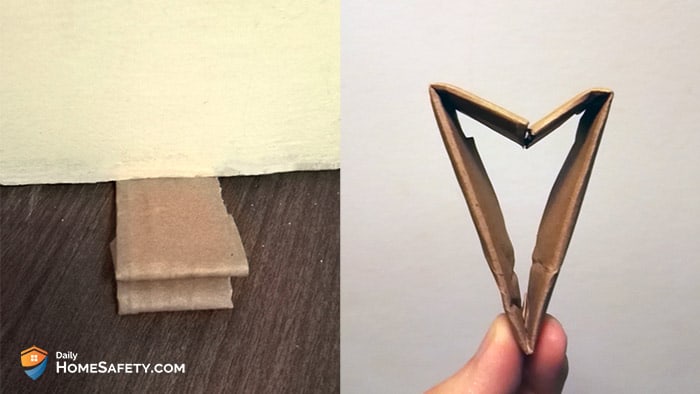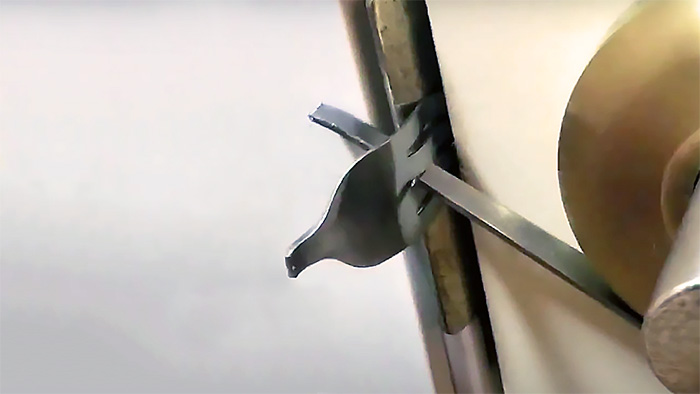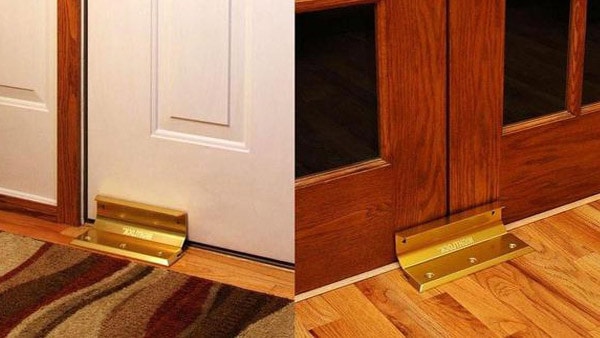Inside Of A Bedroom Door Lock
There could be many situations where you need to lock a door without a lock. You may want to secure a bedroom, a bathroom, or any other interior door or you just want to lock your front (or back) door without using keys.
Sometimes you need a temporary solution to keep a door shut when you're on a vacation or if you travel a lot. Over the years I tried a bunch of different methods, so I know exactly what works.
Without further ado, let's see the best tried-and-tested ways to lock any door without a lock quickly and easily.
1. Use a Wedge to Lock a Door
Many of you have probably already heard about this method but I certainly didn't want to leave it off the list because it's so simple yet powerful.
When you want to lock a door without a lock using a wedge (or door stop) you have basically two options:
- you can either get a ready-to-use wedge-shaped door stopper (it's available in every home improvement store and you can get one for only one or two bucks),
OR
- you can use a DIY door wedge made from cardboard
You can choose any of the two options, both will keep your door shut (to a certain extent).
If you don't have a doorstop at home, I encourage you to make your own door wedge from cardboard.
You can easily make one in a minute: just fold a piece of cardboard into a wedge shape (check out the photo below to get a closer idea of what I'm talking about).

When you want to keep your door closed, just slide the wedge underneath. It's that simple. You can use it for both interior and exterior doors, including bedroom and bathroom doors.
Note: If you want to use a commercial door stopper to lock a door, make sure it's made of rubber to prevent slipping under pressure.
Pro Tip: If you want to make sure your door remains closed even if someone tries really hard to open it, I suggest you use your wedge in combination with another method (check out the next items on the list).
Alternatively, instead of cardboard, you can use a thick sock to make a wedge and stuff it under the door. In most cases, that will also prevent the door from opening, however, don't forget to test it to make sure it really blocks the door.
Of course, this method is not perfect (and won't replace a real lock) but if you want to lock a door without a lock quickly and easily, you should definitely consider trying it.
Pros:
- Very simple and cost-effective method
- Doorstops are widely available but you can quickly do your own door wedge
- Easy to remove when you want to open the door
Cons:
- It won't withstand forced entry attacks for long
- The wedge might slip out from under the door (to prevent that situation do some testing after you put the wedge in place)
- Only works on inward opening doors
Here you can learn more about the proper use of door stops.
2. Lock a Door With a Fork
It might sound weird, but an ordinary fork can be used not only for dining but also to lock a door and keep unwanted visitors from entering a room or a house.
So how can you make a lock out of a fork?
First of all, to make your own DIY door lock some changes need to be made to the fork (so make sure it's not an indispensable part of your tableware):
- First, you will need to bend over about 0.4 inches of the end of the fork. You can easily do that with a plier but you can also use a vise and a hammer.
- Then you have to cut the handle off the fork (be careful the edges may be sharp!).
Now that your DIY two-part fork lock is ready, here's how to use it to lock a door:
- As a first step, open the door and hook the head of the fork into the hole of the strike plate.
- Close the door.
- Slide the fork handle in between the middle tines (teeth).
- Now the door is locked.

Note: In order to make this work properly, you need to use a fork with a flat (and not rounded) handle.
FYI – While this hack will prevent pushing the door open, it won't protect against high force attacks, such as kick-ins (click here to see how to prevent a door from being kicked in). However, it's still a quick and easy way to lock a door without a lock.
Make sure you also check out the video below to get a complete picture of how this method works:
3. Put a Chair Under the Door Handle
This is another proven and time-tested way to lock a door without modifying it. Chances are good that you've already heard about it but I'm here to tell you that although it may sound too simple, it's a really powerful way to barricade a door from the inside (when done right).
This is how it works:
- You place the back of a chair tightly under the handle of the door.
- This will keep the bolt in place simply because the chair prevents pushing the handle down from both the inside and outside.

To get the best result, I suggest you use an office chair so you can easily adjust the height of the back. If you only have non-adjustable chairs at home, you will probably need to raise the height by placing chair raisers or other solid objects under the legs.
Keep in mind that this method only works on doors that have a lever and not a knob.
What if a door has a doorknob (and not a lever) and you want to lock it using a chair?
You can still do it but it will work only if the door opens inward. Make sure you use a sturdy chair and wedge it tightly under the knob (only the two back legs of the chair should touch the floor). Keep in mind that it won't withstand tremendous force, so you may want to use it only as an extra layer of protection.
4. Use a Belt to Lock a Door
Basically, you can use a belt to keep a door shut in two different cases: when a door has a hook (like most bathroom doors) and when a door is equipped with a door closer.
This is how you can lock a door that has a hook using a belt:
In order to keep the door closed, all you need to do is stretch the belt between the hook and the handle. This way the handle cannot be pushed down and the bolt stays in place. Again, this method can be applied mostly on bathroom doors as it won't work without a hook.
Check out the photo below:

How to use your belt on a door with an auto door closer?
In schools, offices, and other commercial buildings doors are often equipped with an automatic door closer. In that case, you can tighten the belt on the hinge to securely lock the door. The goal is to keep the two arms of the door tightly together to prevent the door from opening.
5. Portable Door Lock: Extra Security In Seconds
Portable locks are extremely popular nowadays, and for a reason: they not only provide an easy and secure way to lock a door without a lock but you can also add them as an extra lock to make sure nobody can enter through the door, not even those who have a key.
Portable door locks were originally designed for traveling purposes, however, you can use them in any other situation as well (for instance, if you just want some privacy). Keep in mind that they only allow you to secure a door from the inside.
Addalock is one of those portable door locks I highly recommend checking out. It's a small device that's very easy to use and requires no real installation (so no screwing or drilling). Adding security to a door is just a matter of seconds.

You can use it on doors that already have a lock (think of hotel and rented rooms, college dorms, apartment doors, or your front door) to get additional security, but you can also use it on a bedroom or bathroom door or any other door that has no built-in locking system. By the way, if you need to secure a bedroom door, make sure you also check out our list of the best methods here.
Instead of Addalock (as an alternative), you can also use a door jammer ( such as this one ).
It's rather a portable barricade than a lock: one part of it should be placed under the door while the other part (the extension foot) rests on the floor. To be honest, I've never tried this product, so I can't share my own experiences but I think it works best on floors that are not slippery. Anyway, it could be a reasonable choice for inward opening doors without a lock.
This is another portable security device (check out the photo below) that you can use to keep a door closed from the inside. You can install it without using any tools, so it's another handy solution if you don't want to make permanent changes to the door or the frame. Keep in mind that it won't work if the gap between the jamb (the strike plate) and the door isn't wide enough.

6. Use a (Portable) Security Bar to Keep a Door Shut
Security bars are widely available and most of them do a pretty good job when it comes to reinforcing a door from the inside. This model from Brinks is my favorite (however the one from Sabre also does a great job). It will definitely help you keep undesirable persons outside.
If you want some privacy, all you have to do is place the top yoke under the knob and let the padded foot rest on the floor. You can easily adjust the height of the device within a specific range, so it will fit most hinged doors. However, you can also use it on sliding doors .
Check this video out to see exactly how it works:
The Brinks security bar is made of heavy-duty steel, so it's really sturdy and durable. It offers a really simple and quick solution to lock most doors without having to use a traditional lock.
While security bars can be used without installation and are completely portable, I wouldn't recommend using them if you want to travel light just because they're much heavier and bigger than the previously mentioned items.
7. Add a Keyless Door Reinforcement Lock
If you're not afraid of a little DIY, installing a keyless door lock could be a safe and secure way of locking both interior and exterior doors (from the inside). However, for obvious reasons, they are not suitable for traveling (unless your host doesn't mind if you drill holes into the doorframe).
Let's start with my favorite model, this door reinforcement lock from Defender Security. This small device is very popular among those who need a permanent solution to lock a door without a lock.

Here are some of its advantages:
- It can withstand tremendous forces (up to 800 lbs. according to the manufacturer), so it can be effective even against kick-ins.
- Very easy to use: you can quickly lock and unlock the door in a single motion.
- It highly improves security on both interior and exterior doors (it's an especially useful addition for those without a deadbolt).
- Installation is usually not a big deal and can be done within 15 minutes: in most cases, all you have to do is mount the lock to the door jamb (it should be fixed with four screws that are included).
Door bull is another similar product that you can use to add extra security to inward opening doors whether they have a lock or not. Although it requires installation, you can finish the whole process within 10-15 minutes. If you don't like the previous Defender Security model, this one can be a good alternative.
Note: Keep in mind that these types of locks work only with inswing doors.
8. Install a Door Barricade
Using a door barricade is a highly effective way to reinforce a door and keep unauthorized persons from entering a room or your home.
There are many models on the market, I suggest you have a look at this one from Nightlock if you think installing a door barricade would be an ideal solution for you.
What is a door barricade?
It's a simple device that is anchored to the floor and has two parts: the baseplate and the actual barrier. If you want to lock a door, you just have to slide the barrier into the baseplate. A door barricade uses the strength of the floor, therefore it usually withstands greater forces than some other keyless locks.
Just have a look at the photo below:

Why are door barricades so popular?
- They're durable and can provide reliable protection, even against kick-ins
- Easy to install and operate
- Can be used at home, in schools, offices, etc.
- Besides single doors, they can be used to lock double doors and inward opening French doors (hint: if you want to lock double doors or cabinets, a free – although not as secure – method is to bind the handles together)
If you need to lock an outward opening door, check out this model. Also, check out our complete guide on how you can secure outswing doors here.
9. Use a Strike Plate Lock
A strike plate lock is similar to a standard door chain but it's sturdier and more durable. Also, it doesn't damage your door because you can use the existing screw holes of the strike plate to mount it on the jamb.
It's very simple to use, you just have to place the ring part over the door handle to keep your door shut and unwanted visitors outside.
You can install it on doors without any other lock but you can also add it as an extra lock to your front door. A strike plate lock can significantly improve security even if your door has a deadbolt.
+ 1: Get Rid of the Door Handle On the Exterior Side of the Door
I suggest you only use this method in case of an emergency when there's no other viable solution.
For instance, if your front door lock brokes and you have to leave your home to get a new one, you can temporarily remove the exterior handle to make it harder to get into your home while it's empty.
While this method works on both outward and inward opening doors, it's pretty time-consuming, therefore it's not recommended unless there's no other reasonable way to keep your door locked.
Locking a Door Without a Lock: Putting It All Together
As you can see, there are plenty of ways to lock a door without a lock. So which one should you choose?
Before starting to apply any of the methods, you should decide if you need a permanent fix or just a quick temporary solution.
If all you need is a quick fix, I suggest you choose from the first four methods on the list. If security is a concern, combine the methods with each other. For instance, you can use a wedge and a chair at the same time to lock a door.
If you need protection for a longer time, I highly recommend that you get one (or two) above-mentioned security device. Most of them are pretty affordable and they do a great job when it comes to keeping a door closed whether it has a lock or not.
Source: https://dailyhomesafety.com/how-to-lock-a-door-without-a-lock/

0 Komentar